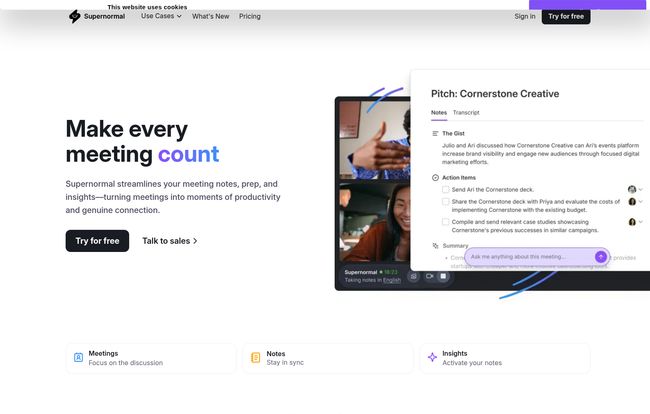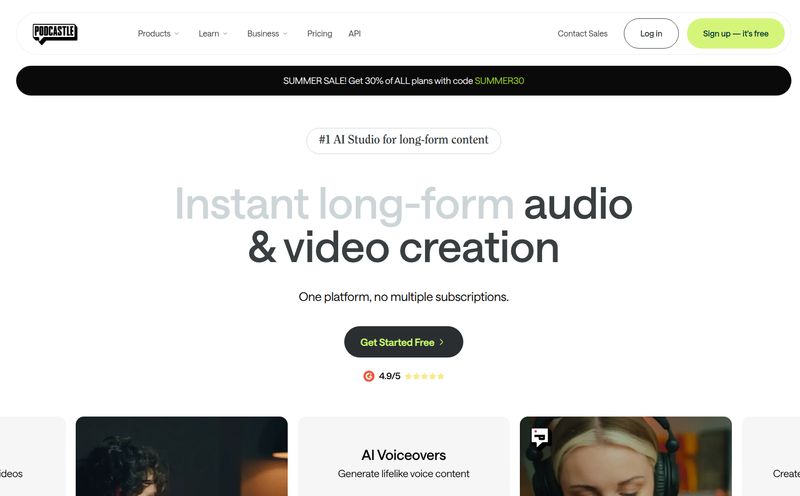Raise your hand if you've ever been in a meeting, trying to contribute a brilliant idea, while also frantically typing notes and praying you're spelling everyone's name right. My hand is way up. It’s that classic meeting paradox: you have to be present enough to participate, but also detached enough to document everything. It's exhausting.
We've all been there, staring at a Google Doc filled with half-finished sentences and misspelled action items, trying to piece together the conversation like some kind of corporate detective. For years, my solution was to just be the fastest typer in the virtual room. It wasn't a great solution. Then I stumbled upon Supernormal, an AI meeting assistant that promised to take the notes for me. Skeptical? I was. But as an SEO guy who lives and breathes efficiency (and has way too many meetings), I had to give it a shot.

Visit Supernormal
So, What Exactly is Supernormal?
Think of Supernormal as a silent participant in your meetings whose only job is to listen and take perfect notes. It’s an AI-powered platform that joins your Google Meet, Zoom, or Microsoft Teams calls and just… handles it. It automatically records, transcribes, and then—this is the cool part—summarizes the entire conversation. It pulls out key decisions, and assigns action items.
They’ve even personified their AI as “Norma.” It’s a bit kitschy, but it works. Instead of some faceless algorithm, you have Norma, your trusty AI scribe. It’s a simple shift, but it makes the whole experience feel a lot more like having an assistant and a lot less like being monitored by Skynet. This tool is designed to turn meetings from a necessary evil into moments of actual, genuine connection and productivity. A lofty goal, I know.
The Supernormal Features I Actually Use
A lot of SaaS tools come loaded with features you'll never touch. They look great on a pricing page but collect digital dust. With Supernormal, I found myself consistently relying on a few core things that have genuinely changed my workflow.
The Magic of Automated Meeting Notes
This is the main event, the whole reason we're here. The first time I finished a meeting and got a notification that my notes were ready, I felt a little giddy. I clicked, and there it was: a clean, well-organized summary. It had a brief overview, a list of action items with names assigned, and a full transcript if I needed to check a specific detail. It's not just a block of text; it's structured information. My own notes often look like a bomb went off in a dictionary. Norma’s notes are neat, tidy and make sense. It’s a small miracle.
Plugging Into Your Workflow with Integrations
A tool is only as good as its ability to play nice with others. This is where Supernormal really shines for me. I can automatically send my meeting notes and action items to Slack, Asana, or ClickUp. It sounds simple, but it closes the loop. The action item from the meeting doesn't just live in Supernormal; it appears directly in our project management tool, assigned to the right person. For sales teams, the Salesforce and Hubspot integrations are probably a massive win. It’s about removing friction, and this does it beautifully.
A Quick Word on Asynchronous Video
This one's interesting. Supernormal lets you send asynchronous video updates. Instead of scheduling yet another 15-minute sync-up, you can just record a quick video of your screen and yourself, and send it to your team. They can read the AI-generated notes instead of watching the whole thing. I've used this a few times for quick weekly updates, and it’s been a fantastic way to cut down on calendar clutter. It’s a very 2024 way of working, and I’m here for it.
My Honest Take After Weeks of Meetings
Okay, so here's the personal story. I was managing a big content migration project, which meant daily check-ins with writers, developers, and the client. The meetings were fast-paced and full of tiny but crucial details. Before Supernormal, I'd end each call with a mild tension headache and a page of cryptic notes. I was so focused on capturing what was said that I sometimes missed the chance to ask why.
After installing Supernormal, the change was immediate. In the very next meeting, I let Norma do the heavy lifting. I could lean back, actually listen, and engage in the conversation. When the developer mentioned a potential blocker, I wasn't busy typing 'blocker-dev-check-later'. I was able to ask follow-up questions and we solved the problem right there on the call. The AI isn't just about saving time after the meeting; for me, it’s about making the time in the meeting more valuable.
Breaking Down the Supernormal Pricing Tiers
Alright, lets talk about the cost. No tool is perfect if it breaks the bank. Supernormal has a pretty straightforward pricing structure, including a genuinely useful free plan.
- Free (Starter): This is perfect for trying it out or for individuals who have infrequent meetings. You get the core AI model and all the integrations. The main limitation is the 1,000 minutes of storage per member. It’s a generous starting point.
- Pro Plan: This is the sweet spot in my opinion. For $10/member/month (billed annually) or $18 monthly, you get unlimited storage. This is huge. It also adds meeting notes templates and the ability to record video. If you have more than a couple of meetings a week, this is the one to get.
- Business Plan: At $19/member/month (billed annually) or $29 monthly, this tier is for larger teams and organizations. It includes everything in Pro, plus more advanced AI models, custom templates, and admin controls for managing the whole team. If you need SOC 2 compliance and better security oversight, this is your plan.
The fact that the core integrations are available on the free plan is a big plus. They aren't holding the most useful features hostage to force an upgrade. You can genuinely get a feel for the entire workflow before paying a dime.
The Good, The Bad, and The AI
No Supernormal review would be complete without a balanced look. While I've been singing its praises, it's not perfect. I've always felt that honesty is the best policy in reviews. On one hand, the time-saving is undeniable. My focus in meetings has improved dramatically, and having a searchable archive of every conversation is like a safety net for my forgetful brain. It's also great for asynchronous collaboration, making it easier for team members in different time zones to stay in the loop.
However, you are putting a lot of faith in an AI. While Norma is surprisingly accurate, it can occasionally misinterpret a name or miss the nuance in a sarcastic comment. You still need to give the notes a quick once-over. The storage limits on the free plan can also be a pain point if you’re meeting-heavy. And of course, there’s the potential to become a bit too dependent on it, but that's a risk with any good productivity tool, right?
Who Should Give Supernormal a Shot?
So, who is this for? Honestly, almost anyone who sits in virtual meetings. But to be more specific:
- Project Managers & Team Leads: Keeping track of action items and decisions across multiple projects is a nightmare. This automates the most tedious part of your job.
- Agencies & Client-Facing Roles: You can be fully present with your clients, knowing every commitment and detail is being captured accurately.
- Remote & Hybrid Teams: It's a fantastic tool for documentation and keeping everyone aligned, no matter where they are.
- Busy Founders & Executives: Your time is your most valuable asset. Offload the mental burden of note-taking and focus on strategy.
Your Supernormal Questions, Answered
How does the meeting storage work?
On the Free plan, you get a pool of 1,000 minutes of storage per team member. Every meeting you record with Supernormal uses up some of those minutes. The Pro and Business plans offer unlimited storage, so you never have to worry about it.
What happens if I go over my storage limits on the free plan?
If you hit your storage limit, you won't be able to record new meetings or get notes until you either upgrade your plan or delete old meetings to free up space. It's a pretty standard model for freemium SaaS products.
Is my meeting data secure with Supernormal?
This is a big one. According to their site, they take security seriously. They are SOC 2 compliant, which is a key industry standard for data security. They also use TLS 1.2 and AES-256 encryption to protect your data both in transit and at rest. As always, you should review any platform's security policies to make sure you're comfortable.
How accurate is the AI transcription and summary?
In my experience, it's impressively accurate—I'd say in the 95-98% range for clear audio. It occasionally fumbles with strong accents, highly technical jargon, or when people talk over each other. The summaries are generally excellent at pulling out the main points, but I always recommend a quick 30-second proofread.
Can I use Supernormal with Microsoft Teams?
Yes! It integrates directly with Microsoft Teams, as well as Google Meet and Zoom. So it covers the big three video conferencing platforms.
My Final Verdict on This AI Meeting Assistant
So, is Supernormal the magic bullet that will make you love all your meetings? Probably not. Some meetings are just destined to be duds. But what it does do is remove one of the biggest sources of friction and mental load associated with them. It gives you back your focus.
It's one of those rare tools that, after a week of use, makes you wonder how you ever managed without it. It's like switching from a flip phone to a smartphone; you just can't go back. For me, the investment in a Pro plan pays for itself in the first few meetings of the month, purely in terms of saved time and reduced stress. If you're tired of the note-taking dance, I'd say giving the Supernormal free plan a try is a no-brainer.



